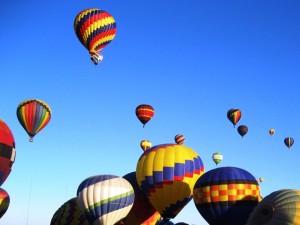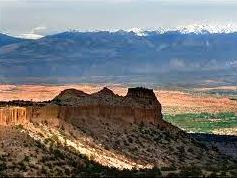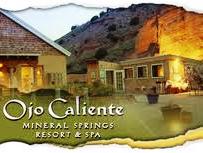» posted on Saturday, November 3rd, 2012 by Linda Lou Burton
The Air and The Waters
 Linda Burton posting from Santa Fe, New Mexico – “The air.” That has been the answer by many as I have asked the question “What do you like best about Santa Fe?” Santa Fe is the country’s highest capital city with an elevation of 7,000 feet, give or take a few depending on which side of town you’re on. It is high desert country, with about 320 days of sunshine a year. It sits at the foot of the Sangre de Cristo Mountains, that sub-range of the Rockies that extends 240 miles from Colorado into New Mexico. Near Taos to the north is Wheeler Peak, New Mexico’s highest point, at 13,161 feet; just outside Santa Fe is Truchas Peak, at 13,102. So here you have a pretty place where the sun almost always
Linda Burton posting from Santa Fe, New Mexico – “The air.” That has been the answer by many as I have asked the question “What do you like best about Santa Fe?” Santa Fe is the country’s highest capital city with an elevation of 7,000 feet, give or take a few depending on which side of town you’re on. It is high desert country, with about 320 days of sunshine a year. It sits at the foot of the Sangre de Cristo Mountains, that sub-range of the Rockies that extends 240 miles from Colorado into New Mexico. Near Taos to the north is Wheeler Peak, New Mexico’s highest point, at 13,161 feet; just outside Santa Fe is Truchas Peak, at 13,102. So here you have a pretty place where the sun almost always  shines, it doesn’t get too hot or too cold, and the air is clean. Very attractive! Santa Fe air has been attracting people for thousands of years; it appears to have both an inspirational and a healing effect on those who come. John Gaw Meem (the architect) came to recover from tuberculosis in 1920, where he met Carlos Vierra (the artist) at Sunmount Sanatorium (we’ve already talked about them). Sunmount was in business from the early 1900’s to that point in time when medication became available for the disease; it offered patients clean dry air and a chance to rest, far from the pressures of the madding crowd.
shines, it doesn’t get too hot or too cold, and the air is clean. Very attractive! Santa Fe air has been attracting people for thousands of years; it appears to have both an inspirational and a healing effect on those who come. John Gaw Meem (the architect) came to recover from tuberculosis in 1920, where he met Carlos Vierra (the artist) at Sunmount Sanatorium (we’ve already talked about them). Sunmount was in business from the early 1900’s to that point in time when medication became available for the disease; it offered patients clean dry air and a chance to rest, far from the pressures of the madding crowd.
Tuberculosis wasn’t the only ailment that brought people from the fever-stricken lowlands in the south and the polluted air in the industrialized north. Physicians, climatologists, and all sorts of people believed that climate affected disease. Asthma, allergies, depression, fevers, frailty, neuralgia, mental breakdowns, paralysis, pneumonia, and even lung troubles resulting from exposure to mustard gas in World War I were some of the reasons people came to the Southwest. Sanatorium treatment (common around the globe) stressed altitude, tranquility, and the quality of the air; just what was available in New Mexico. People who came wrote about their experiences; climatologists linked “electrified air” and temperature to recovery from a number of diseases.
The railroad industry played a role in “health boosterism’ too. Railroads blanketed the country with promotional materials encouraging the long trek to the Southwest for those seeking fortunes or wellness; cities joined in – “Why sacrifice health for wealth when you can have both?” read the ads. Skeptics doubted the claims, but since there were no reliable medical treatments for many diseases at the time, people hoped for the best and came by the tens of thousands. In 1913 a US Public Health Service physician estimated that 26% of New Mexico households contained at least one tubercular and that 90% of such households were not native New Mexicans.
Health seekers played a significant role in the development of New Mexico; many of the original sanatoria became leading hospitals of today. And people still come for “the air” and what it does for body and soul. But it’s not just the air that seems to make people feel better here; the mineral springs get credit too. Santa Fe offers more world-class spas than any city of its size. Did you know that SPA is an acronym for the Latin phrase “Salus Per Aquas,” which means “health through water”?
 I love the story of Ojo Caliente Mineral Springs, about 50 miles north of Santa Fe, one of the oldest natural health resorts in the nation. http://www.ojospa.com/ It was a sacred place to the Native Americans of New Mexico; sulphur-free geothermal mineral waters still flow from a subterranean volcanic aquifer. It claims to be the only hot springs in the world with four different types of mineral water – lithia, iron, soda and arsenic. Today you can choose from ten pools according to your need; lithia is believed to relieve depression and aid digestion; iron is considered to be beneficial to the blood and immune system; soda is used to relieve digestive problems; arsenic waters may be beneficial for relief from arthritis, stomach ulcers and skin conditions.
I love the story of Ojo Caliente Mineral Springs, about 50 miles north of Santa Fe, one of the oldest natural health resorts in the nation. http://www.ojospa.com/ It was a sacred place to the Native Americans of New Mexico; sulphur-free geothermal mineral waters still flow from a subterranean volcanic aquifer. It claims to be the only hot springs in the world with four different types of mineral water – lithia, iron, soda and arsenic. Today you can choose from ten pools according to your need; lithia is believed to relieve depression and aid digestion; iron is considered to be beneficial to the blood and immune system; soda is used to relieve digestive problems; arsenic waters may be beneficial for relief from arthritis, stomach ulcers and skin conditions.
 These ancient springs have been a gathering place and source of healing for thousands of years. Pottery shards and other artifacts show that four large pueblos surrounded the springs, home to thousands of people; the village was named Posi. Traditions say that warring tribesmen would set their weapons aside to gather in peace at the springs, trading and healing their wounds without conflict. When the Spanish came in the 1500’s seeking gold, the first explorer wrote “The greatest treasure I have found…are the hot springs. I have named them Ojo Caliente.”
These ancient springs have been a gathering place and source of healing for thousands of years. Pottery shards and other artifacts show that four large pueblos surrounded the springs, home to thousands of people; the village was named Posi. Traditions say that warring tribesmen would set their weapons aside to gather in peace at the springs, trading and healing their wounds without conflict. When the Spanish came in the 1500’s seeking gold, the first explorer wrote “The greatest treasure I have found…are the hot springs. I have named them Ojo Caliente.”
Forward to 1868, when Antonio Joseph, New Mexico’s first Territorial Representative to Congress who was himself healed by the waters here, built a bath house; soon the area had overnight lodging, a post office, and a general store, where ledgers show that Kit Carson frequently purchased supplies. Three original buildings are National Historic Places: the Historic Bathhouse (1868), the Historic Hotel (1916), and the Adobe Round Barn (1924).
The history, the scenery, and the springs are awesome, but if you’re just looking for a few hours of getting the kinks out of your system, Santa Fe is full of enticing day spas. At Ten Thousand Waves, http://www.tenthousandwaves.com/ you can get Ashi Anma Foot Massage, Deep Stone Massage, Thai Massage, and Four Hands Massage. An example of short spa services is a regular private bath, an Ashi Anma Foot Massage, a CryoPeel stem cell facial, a Yasuragi Head & Neck Treatment, and a Salt Glow; 3 hours for $275.
Intrigued by the idea of a Chile and Honey Wrap, or a Turquoise Gem Massage? Maybe Native American methods interest you; at the Spirit of Santa Fe they follow the four directions of the Medicine Wheel with a blue cornmeal and tobacco scrub, sage tea, a cedar oil massage, and a sweetgrass tea herbal wrap. Most of the hotels have day spas; Eldorado has the Nidah, Madeline Inn has Absolute Nirvana, La Posada has Rock Resorts Spa. There’s The Spa at Hotel Santa Fe, The Spa at Loretto, and Downtown Day Spa. Travel a bit further to ShaNah Spa at Bishop’s Lodge; they have an authentic Native American tepee at the base of those Sangre de Cristos.
The air, the water, the sun, it’s all here in Santa Fe. Relax, and be well, that’s the message.
